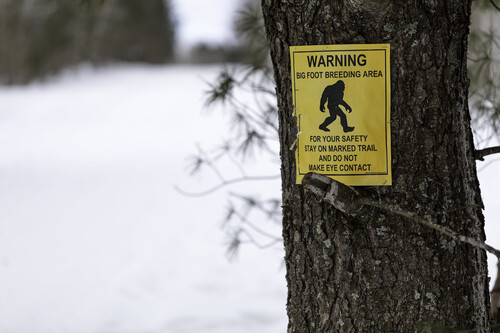Bigfoot believers, rejoice: After years of searching, the hairy monster may finally get legal recognition in the state of California. However, there’s a fine line between believing something and accepting that it’s important.
California’s official cryptid. Recently, California Assemblymember Chris Rogers, who represents the state’s North Coast, introduced a bill that aims to establish Bigfoot as the state’s official cryptid. For the unordained, which included yours truly before I started writing this, a cryptid is an animal that people believe exists despite the lack of official proof.
Cryptids, explained. Along with werewolves and creatures like the chupacabra, Bigfoot is one of the most famous cryptids in the field. There are also cryptozoologists, which are people who dedicate their lives to studying cryptids (though it’s unclear whether it’s a viable career choice).
Interestingly, some animals that we know are real today started off as cryptids. One example is the Komodo dragon, the world’s largest lizard. It gained renown in 1910 after Lieutenant van Steyn van Hensbroek heard local rumors in Indonesia about a “land crocodile.” Van Hensbroek eventually captured a Komodo dragon. Years later, American researchers launched an expedition to study the lizards.
The legend of Bigfoot. As for Bigfoot, the hairy creature is considered to be California’s most famous legend. In an interview with SFGate, Eric Wilson, a volunteer with the China Flat Museum & Bigfoot Collection in the town of Willow Creek, said the legend’s roots date back to 1958. That year, a road crew from Willow Creek was sent out to carve out new logging roads and kept stumbling upon something weird: massive, human-like footprints.
Jerry Crew, one of the road supervisors who had found footprints, was frustrated that people didn’t believe him. After getting advice from a local taxidermist, Crew decided to use a quick-setting gypsum plaster to capture the footprint in 1958. Once he had the plaster cast, he went straight to the newspaper with his finding“They named it Bigfoot,” Nelson, the Bigfoot museum volunteer, said. “Up until then, there were regional names for a hairy beast—Native American names—but they named it Bigfoot.”

Bigfoot believers react. Matt Moneymaker, one of the most prominent Bigfoot researchers in the field, thought AB 666—yes, that’s the real number—was a joke when he first heard about it. However, once he learned that the bill was legit, Moneymaker said it made sense because California is the state where the term “Bigfoot” was popularized.
As a point of clarification, Moneymaker told SFGate that there’s not just one Bigfoot, but rather a “population of animals” that live across the state of California. He’s been fascinated by the myth since the 1980s and is president of the Bigfoot Field Researchers Organization.
“I’ve gotten close to them several times,” Moneymaker said. “I had a face-to-face encounter one time, after which I was absolutely sure they existed because I had one about 20 feet in front of me, growling at me.”
Looking forward. It’s not clear whether Rogers, the California Assemblymember behind AB 666, is a Bigfoot believer himself, but he certainly doesn’t have to be to introduce the bill. If the bill passes, it would likely be a boom for the district he represents. Rogers’ district includes Willow Creek, a small town that, besides having a Bigfoot museum, has a Bigfoot Motel, Bigfoot Steakhouse, and more. In short, it’s a town obsessed with Bigfoot.
Nelson, the Bigfoot museum volunteer, points out that Bigfoot isn’t just a legend for the people of Willow creek.
“A lot of people believe it exists,” he said.
Images | Lorie Shaull | Wikimedia Commons


